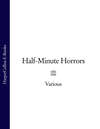Buch lesen: «Harper's New Monthly Magazine, No. XXVI, July 1852, Vol. V»
THE ARMORY AT SPRINGFIELD
BY JACOB ABBOTT
SPRINGFIELD
The Connecticut river flows through the State of Massachusetts, from north to south, on a line about half way between the middle of the State and its western boundary. The valley through which the river flows, which perhaps the stream itself has formed, is broad and fertile, and it presents, in the summer months of the year, one widely extended scene of inexpressible verdure and beauty. The river meanders through a region of broad and luxuriant meadows which are overflowed and enriched by an annual inundation. These meadows extend sometimes for miles on either side of the stream, and are adorned here and there with rural villages, built wherever there is a little elevation of land – sufficient to render human habitations secure. The broad and beautiful valley is bounded on either hand by an elevated and undulating country, with streams, mills, farms, villages, forests, and now and then a towering mountain, to vary and embellish the landscape. In some cases a sort of spur or projection from the upland country projects into the valley, forming a mountain summit there, from which the most magnificent views are obtained of the beauty and fertility of the surrounding scene.
There are three principal towns upon the banks of the Connecticut within the Massachusetts lines: Greenfield on the north – where the river enters into Massachusetts from between New Hampshire and Vermont – Northampton at the centre, and Springfield on the south. These towns are all built at points where the upland approaches near to the river. Thus at Springfield the land rises by a gentle ascent from near the bank of the stream to a spacious and beautiful plain which overlooks the valley. The town is built upon this declivity. It is so enveloped in trees that from a distance it appears simply like a grove with cupolas and spires rising above the masses of forest foliage; but to one within it, it presents every where most enchanting pictures of rural elegance and beauty. The streets are avenues of trees. The houses are surrounded by gardens, and so enveloped in shrubbery that in many cases they reveal themselves to the passer-by only by the glimpse that he obtains of a colonnade or a piazza, through some little vista which opens for a moment and then closes again as he passes along. At one point, in ascending from the river to the plain above, the tourist stops involuntarily to admire the view which opens on either side, along a winding and beautiful street which here crosses his way. It is called Chestnut-street on the right hand, and Maple-street on the left – the two portions receiving their several names from the trees with which they are respectively adorned. The branches of the trees meet in a dense and unbroken mass of foliage over the middle of the street, and the sidewalk presents very precisely the appearance and expression of an alley in the gardens of Versailles.
THE ARMORY GROUNDS
On reaching the summit of the ascent, the visitor finds himself upon an extended plain, with streets of beautiful rural residences on every hand, and in the centre a vast public square occupied and surrounded by the buildings of the Armory. These buildings are spacious and elegant in their construction, and are arranged in a very picturesque and symmetrical manner within the square, and along the streets that surround it. The grounds are shaded with trees; the dwellings are adorned with gardens and shrubbery. Broad and neatly-kept walks, some graveled, others paved, extend across the green or along the line of the buildings, opening charming vistas in every direction. All is quiet and still. Here and there a solitary pedestrian is seen moving at a distance upon the sidewalk, or disappearing among the trees at the end of an avenue; and perhaps the carriage of some party of strangers stands waiting at a gate. The visitor who comes upon this scene on a calm summer morning, is enchanted by the rural beauty that surrounds him, and by the air of silence and repose which reigns over it all. He hears the distant barking of a dog, the voices of children at play, or the subdued thundering of the railway-train crossing the river over its wooden viaduct, far down the valley – and other similar rural sounds coming from a distance through the calm morning air – but all around him and near him is still. Can it be possible, he asks, that such a scene of tranquillity and loveliness can be the outward form and embodiment of a vast machinery incessantly employed in the production of engines of carnage and death?
It is, however, after all, perhaps scarcely proper to call the arms that are manufactured by the American government, and stored in their various arsenals, as engines of carnage and destruction. They ought, perhaps, to be considered rather as instruments of security and peace; for their destination is, as it would seem, not to be employed in active service in the performance of the function for which they are so carefully prepared; but to be consigned, when once finished, to eternal quiescence and repose. They protect by their existence, and not by their action; but in order that this, their simple existence, should be efficient as protection, it is necessary that the instruments themselves should be fitted for their work in the surest and most perfect manner. And thus we have the very singular and extraordinary operation going on, of manufacturing with the greatest care, and with the highest possible degree of scientific and mechanical skill, a vast system of machinery, which, when completed, all parties concerned most sincerely hope and believe will, in a great majority of cases, remain in their depositories undisturbed forever. They fulfill their vast function by their simple existence – and thus, though in the highest degree useful, are never to be used.
THE BUILDINGS
The general appearance of the buildings of the Armory is represented in the engraving placed at the head of this article. The point from which the view is taken, is on the eastern side of the square – that is, the side most remote from the town. The level and extended landscape seen in the distance, over the tops of the buildings, is the Connecticut valley – the town of Springfield lying concealed on the slope of the hill, between the buildings and the river. The river itself, too, is concealed from view at this point by the masses of foliage which clothe its banks, and by the configuration of the land.
The middle building in the foreground, marked by the cupola upon the top of it, is called the Office. It contains the various counting-rooms necessary for transacting the general business of the Armory, and is, as it were, the seat and centre of the power by which the whole machinery of the establishment is regulated. North and south of it, and in a line with it, are two shops, called the North and South Filing Shops, where, in the several stories, long ranges of workmen are found, each at his own bench, and before his own window, at work upon the special operation, whatever it may be, which is assigned to him. On the left of the picture is a building with the end toward the observer, two stories high in one part, and one story in the other part. The higher portion – which in the view is the portion nearest the observer – forms the Stocking Shop, as it is called; that is the shop where the stocks are made for the muskets, and fitted to the locks and barrels. The lower portion is the Blacksmith's Shop. The Blacksmith's Shop is filled with small forges, at which the parts of the lock are forged. Beyond the Blacksmith's Shop, and in a line with it, and forming, together with the Stocking Shop and the Blacksmith's Shop, the northern side of the square, are several dwelling-houses, occupied as the quarters of certain officers of the Armory. The residence of the Commanding Officer, however, is not among them. His house stands on the west side of the square, opposite to the end of the avenue which is seen opening directly before the observer in the view. It occupies a very delightful and commanding situation on the brow of the hill, having a view of the Armory buildings and grounds upon one side, and overlooking the town and the valley of the Connecticut on the other.
A little to the south of the entrance to the Commanding Officer's house, stands a large edifice, called the New Arsenal. It is the building with the large square tower – seen in the view in the middle distance, and near the centre of the picture. This building is used for the storage of the muskets during the interval that elapses from the finishing of them to the time when they are sent away to the various permanent arsenals established by government in different parts of the country, or issued to the troops. Besides this new edifice there are two or three other buildings which are used for the storage of finished muskets, called the Old Arsenals. They stand in a line on the south side of the square, and may be seen on the left hand, in the view. These buildings, all together, will contain about five hundred thousand muskets. The New Arsenal, alone, is intended to contain three hundred thousand.
THE WATER SHOPS
Such is the general arrangement of the Arsenal buildings, "on the hill." But it is only the lighter work that is done here. The heavy operations, such as rolling, welding, grinding, &c., are all performed by water-power. The stream which the Ordnance Department of the United States has pressed into its service to do this work, is a rivulet that meanders through a winding and romantic valley, about half a mile south of the town. On this stream are three falls, situated at a distance perhaps of half a mile from each other. At each of these falls there is a dam, a bridge, and a group of shops. They are called respectively the Upper, Middle, and Lower Water Shops. The valley in which these establishments are situated is extremely verdant and beautiful. The banks of the stream are adorned sometimes with green, grassy slopes, and sometimes with masses of shrubbery and foliage, descending to the water. The road winds gracefully from one point of view to another, opening at every turn some new and attractive prospect. The shops and all the hydraulic works are very neatly and very substantially constructed, and are kept in the most perfect order: so that the scene, as it presents itself to the party of visitors, as they ride slowly up or down the road in their carriage, or saunter along upon the banks of the stream on foot, forms a very attractive picture.
THE MUSKET BARREL
The fundamental, and altogether the most important operation in the manufacture of the musket, is the formation of the barrel; for it is obvious, that on the strength and perfection of the barrel, the whole value and efficiency of the weapon when completed depends. One would suppose, that the fabrication of so simple a thing as a plain and smooth hollow tube of iron, would be a very easy process; but the fact is, that so numerous are the obstacles and difficulties that are in the way, and so various are the faults, latent and open, into which the workman may allow his work to run, that the forming of the barrel is not only the most important, but by far the most difficult of the operations at the Armory – one which requires the most constant vigilance and attention on the part of the workman, during the process of fabrication, and the application of multiplied tests to prove the accuracy and correctness of the work at every step of the progress of it, from beginning to end.
The barrels are made from plates of iron, of suitable form and size, called scalps or barrel plates. These scalps are a little more than two feet long, and about three inches wide. The barrel when completed, is about three feet six inches long, the additional length being gained by the elongating of the scalp under the hammer during the process of welding. The scalps are heated, and then rolled up over an iron rod, and the edges being lapped are welded together, so as to form a tube of the requisite dimensions – the solid rod serving to preserve the cavity within of the proper form. This welding of the barrels is performed at a building among the Middle Water Shops. A range of tilt hammers extend up and down the room, with forges in the centre of the room, one opposite to each hammer, for heating the iron. The tilt hammers are driven by immense water-wheels, placed beneath the building – there being an arrangement of machinery by which each hammer may be connected with its moving power, or disconnected from it, at any moment, at the pleasure of the workman. Underneath the hammer is an anvil. This anvil contains a die, the upper surface of which, as well as the under surface of a similar die inserted in the hammer, is formed with a semi-cylindrical groove, so that when the two surfaces come together a complete cylindrical cavity is formed, which is of the proper size to receive the barrel that is to be forged. The workman heats a small portion of his work in his forge, and then standing directly before the hammer, he places the barrel in its bed upon the anvil, and sets his hammer in motion, turning the barrel round and round continually under the blows. Only a small portion of the seam is closed at one heat, eleven heats being required to complete the work. To effect by this operation a perfect junction of the iron, in the overlapping portions, so that the substance of iron shall be continuous and homogeneous throughout, the same at the junction as in every other part, without any, the least, flaw, or seam, or crevice, open or concealed, requires not only great experience and skill, but also most unremitting and constant attention during the performance of the work. Should there be any such flaw, however deeply it may be concealed, and however completely all indications of it may be smoothed over and covered up by a superficial finishing, it is sure to be exposed at last, to the mortification and loss of the workman, in the form of a great gaping rent, which is brought out from it under the inexorable severity of the test to which the work has finally to be subjected.
RESPONSIBILITY OF THE WORKMEN
We say to the loss as well as to the mortification of the workman, for it is a principle that pervades the whole administration of this establishment, though for special reasons the principle is somewhat modified in its application to the welder, as will hereafter be explained, that each workman bears the whole loss that is occasioned by the failure of his work to stand its trial, from whatever cause the failure may arise. As a general rule each workman stamps every piece of work that passes through his hands with his own mark – a mark made indelible too – so that even after the musket is finished, the history of its construction can be precisely traced, and every operation performed upon it, of whatever kind, can be carried home to the identical workman who performed it. The various parts thus marked are subject to very close inspection, and to very rigid tests, at different periods, and whenever any failure occurs, the person who is found to be responsible for it is charged with the loss. He loses not only his own pay for the work which he performed upon the piece in question, but for the whole value of the piece at the time that the defect is discovered. That is, he has not only to lose his own labor, but he must also pay for all the other labor expended upon the piece, which through the fault of his work becomes useless. For example, in the case of the barrel, there is a certain amount of labor expended upon the iron, to form it into scalps, before it comes into the welder's hands. Then after it is welded it must be bored and turned, and subjected to some other minor operations before the strength of the welding can be proved. If now, under the test that is applied to prove this strength – a test which will be explained fully in the sequel – the work gives way, and if, on examination of the rent, it proves to have been caused by imperfection in the welding, and not by any original defect in the iron, the welder, according to the general principle which governs in this respect all the operations of the establishment, would have to lose not only the value of his own labor, in welding the barrel, but that of all the other operations which had been performed upon it, and which were rendered worthless by his agency. It is immaterial whether the misfortune in such cases is occasioned by accident, or carelessness, or want of skill. In either case the workman is responsible. This rule is somewhat relaxed in the case of the welder, on whom it would, perhaps, if rigidly enforced, bear somewhat too heavily. In fact many persons might regard it as a somewhat severe and rigid rule in any case – and it would, perhaps, very properly be so considered, were it not that this responsibility is taken into the account in fixing the rate of wages; and the workmen being abundantly able to sustain such a responsibility do not complain of it. The system operates on the whole in the most salutary manner, introducing, as it does, into every department of the Armory, a spirit of attention, skill, and fidelity, which marks even the countenances and manners of the workmen, and is often noticed and spoken of by visitors. In fact none but workmen of a very high character for intelligence, capacity, and skill could gain admission to the Armory – or if admitted could long maintain a footing there.
The welders are charged one dollar for every barrel lost through the fault of their work. They earn, by welding, twelve cents for each barrel; so that by spoiling one, they lose the labor which they expend upon eight. Being thus rigidly accountable for the perfection of their work, they find that their undivided attention is required while they are performing it; and, fortunately perhaps for them, there is nothing that can well divert their attention while they are engaged at their forges, for such is the incessant and intolerable clangor and din produced by the eighteen tilt hammers, which are continually breaking out in all parts of the room, into their sudden paroxysms of activity, that every thing like conversation in the apartment is almost utterly excluded. The blows of the hammers, when the white-hot iron is first passed under them and the pull of the lever sets them in motion, are inconceivably rapid, and the deafening noise which they make, and the showers of sparks which they scatter in every direction around, produce a scene which quite appalls many a lady visitor when she first enters upon it, and makes her shrink back at the door, as if she were coming into some imminent danger. The hammers strike more than six hundred blows in a minute, that is more than ten in every second; and the noise produced is a sort of rattling thunder, so overpowering when any of the hammers are in operation near to the observer, that the loudest vociferation uttered close to the ear, is wholly inaudible. Some visitors linger long in the apartment, pleased with the splendor and impressiveness of the scene. Others consider it frightful, and hasten away.
FINISHING OPERATIONS. – BORING
From the Middle Water Shops, where this welding is done, the barrels are conveyed to the Upper Shops, where the operations of turning, boring and grinding are performed. Of course the barrel when first welded is left much larger in its outer circumference, and smaller in its bore, than it is intended to be when finished, in order to allow for the loss of metal in the various finishing operations. When it comes from the welder the barrel weighs over seven pounds: when completely finished it weighs but about four and a half pounds, so that nearly one half of the metal originally used, is cut away by the subsequent processes.
The first of these processes is the boring out of the interior. The boring is performed in certain machines called boring banks. They consist of square and very solid frames of iron, in which, as in a bed, the barrel is fixed, and there is bored out by a succession of operations performed by means of certain tools which are called augers, though they bear very little resemblance to the carpenter's instrument so named. These augers are short square bars of steel, highly polished, and sharp at the edges – and placed at the ends of long iron rods, so that they may pass entirely through the barrel to be bored by them, from end to end. The boring parts of these instruments, though they are in appearance only plain bars of steel with straight and parallel sides, are really somewhat smaller at the outer than at the inner end, so that, speaking mathematically, they are truncated pyramids, of four sides, though differing very slightly in the diameters of the lower and upper sections.
The barrels being fixed in the boring bank, as above described, the end of the shank of the auger is inserted into the centre of a wheel placed at one end of the bank, where, by means of machinery, a slow rotary motion is given to the auger, and a still slower progressive motion at the same time. By this means the auger gradually enters the hollow of the barrel, boring its way, or rather enlarging its way by its boring, as it advances. After it has passed through it is withdrawn, and another auger, a very little larger than the first is substituted in its place; and thus the calibre of the barrel is gradually enlarged, almost to the required dimensions.
Almost, but not quite; for in the course of the various operations which are subsequent to the boring, the form of the interior of the work is liable to be slightly disturbed, and this makes it necessary to reserve a portion of the surplus metal within, for a final operation. In fact the borings to which the barrel are subject, alternate in more instances than one with other operations, the whole forming a system far too nice and complicated to be described fully within the limits to which we are necessarily confined in such an article as this. It is a general principle however that the inside work is kept always in advance of the outside, as it is the custom with all machinists and turners to adopt the rule that is so indispensable and excellent in morals, namely, to make all right first within, and then to attend to the exterior. Thus in the case of the musket barrel the bore is first made correct. Then the outer surface of the work is turned and ground down to a correspondence with it. The reverse of this process, that is first shaping the outside of it, and then boring it out within, so as to make the inner and outer surfaces to correspond, and the metal every where to be of equal thickness, would be all but impossible.




















